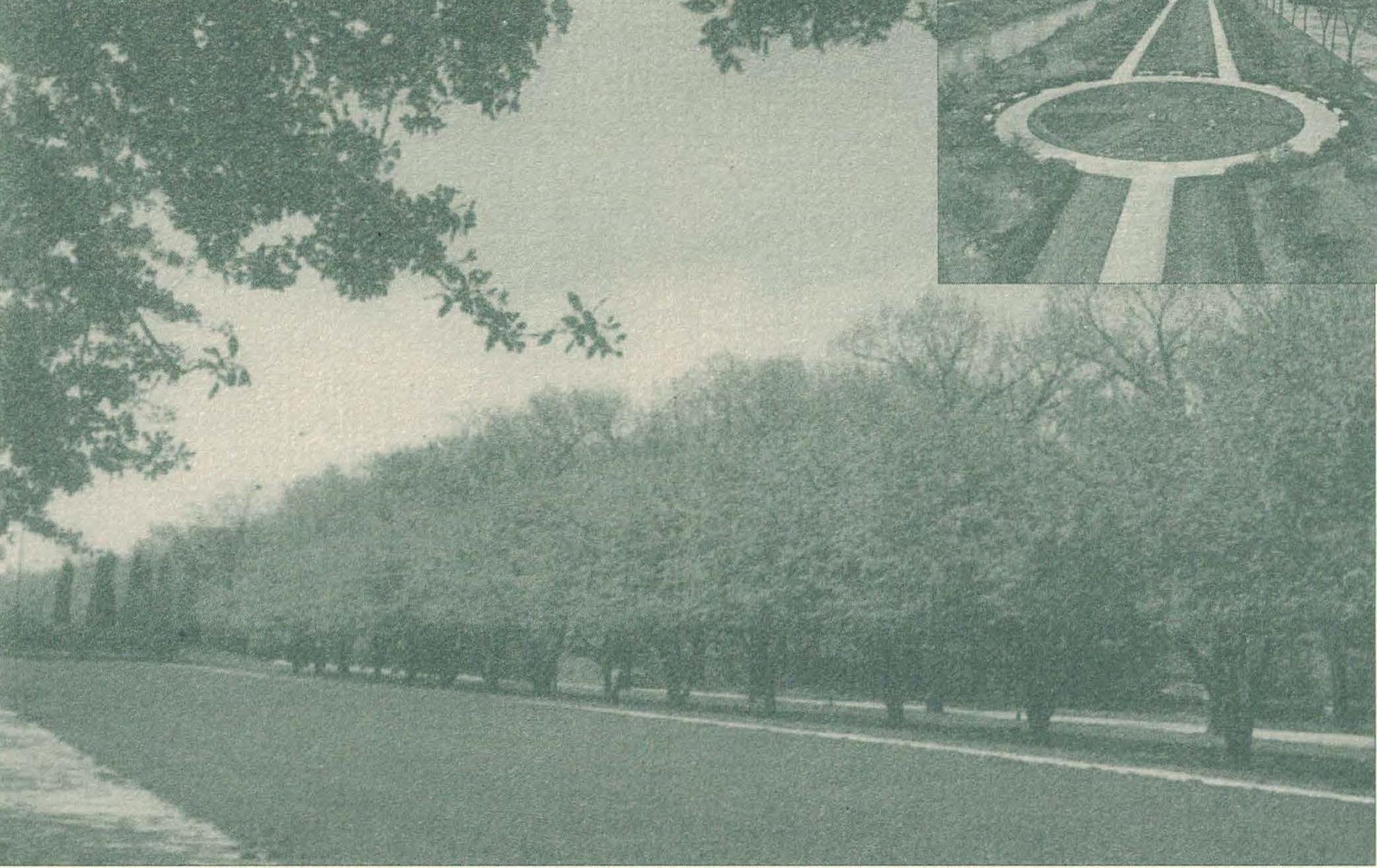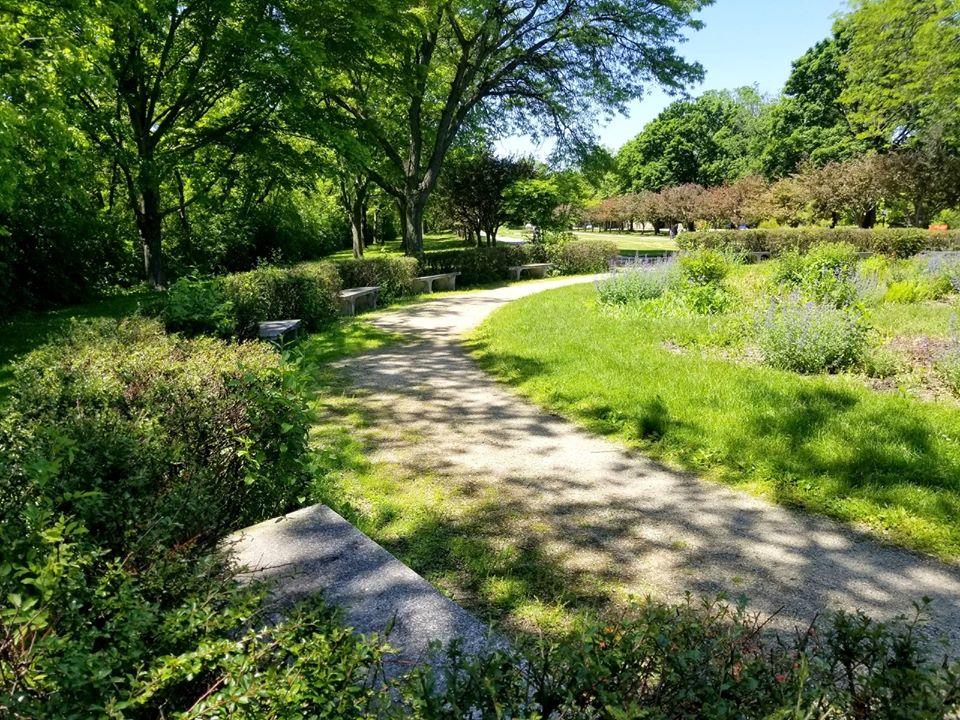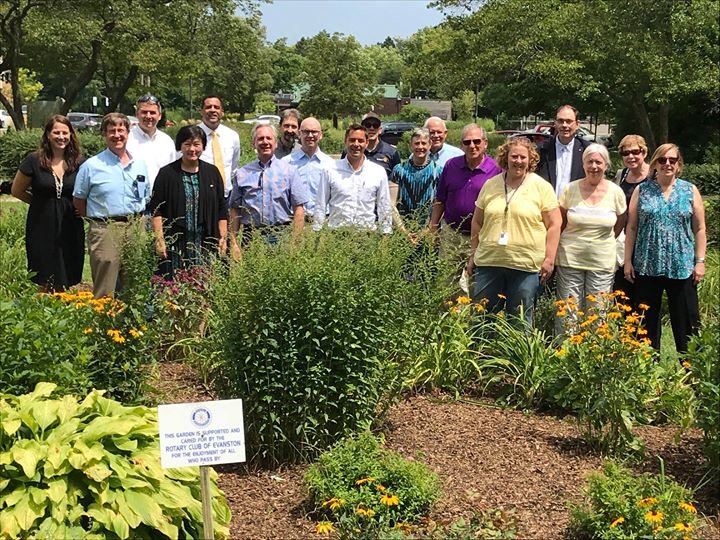A Place for Peaceful Reflection and Inspiration
The International Friendship Garden:
A Public Resource for Evanston
 The Rotary Club of Evanston planned and built the International Friendship Garden in the early 1960s as a living symbol of goodwill toward all people of the earth.
The Rotary Club of Evanston planned and built the International Friendship Garden in the early 1960s as a living symbol of goodwill toward all people of the earth.It is part of Evanston’s 23-acre Ladd Memorial Arboretum, which includes more than 1,000 trees and shrubs. Over the years, a variety of trees have been planted and dedicated here to honor each of the countries represented by Rotary throughout the world. One of the most attractive features of the garden is a large Rotary Wheel created by flowering plants.
Since it was created in the 1960s, the Friendship Garden has been a living expression of Rotary’s principles of goodwill and service to mankind, with lovely plantings, shade trees and paths – a place of serenity, devoted to peace and understanding among nations. It is open to the public and maintained through a partnership between Rotary and the City of Evanston.
How it all began
In 1910, the North Shore Channel (known as “the canal”) was created to carry sewage away from Lake Michigan. The canal cut across Evanston and left on its banks huge mounds of earth and clay, all of which were gradually hauled away for other projects. After WWII, the entire area from Green Bay Road to Golf Road was lined with two-story wooden U.S. Army barracks buildings. These buildings housed military and naval personnel during the war while they were studying at Northwestern University. Later these buildings were used by returning veterans and their families. The City of Evanston finally had the buildings torn down. This left a desolate looking area – since only the concrete slabs remained.
 Edward R. Ladd, a charter member and second president of the Rotary Club of Evanston, was the secretary of the Bowman Publishing Company and the founder and publisher of the Evanston Review. When Ed Ladd died in 1956, a group consisting of Lloyd Hollister, Ralph Melin, Dr. Larry Meyer, Tommy Thomlinson (vice president of State and Trust Co.) and Ray Orwig (editor of the Evanston Review) settled on the idea of creating a city park. Since all of the existing parks were fairly well established, they hit upon the narrow but long strip of unsightly property along the canal and the idea of the Ladd Arboretum was born.
Edward R. Ladd, a charter member and second president of the Rotary Club of Evanston, was the secretary of the Bowman Publishing Company and the founder and publisher of the Evanston Review. When Ed Ladd died in 1956, a group consisting of Lloyd Hollister, Ralph Melin, Dr. Larry Meyer, Tommy Thomlinson (vice president of State and Trust Co.) and Ray Orwig (editor of the Evanston Review) settled on the idea of creating a city park. Since all of the existing parks were fairly well established, they hit upon the narrow but long strip of unsightly property along the canal and the idea of the Ladd Arboretum was born.Development of the Arboretum
The development of the Ladd Arboretum began in 1957. The first section ran from Green Bay Road to Bridge Street. The Arboretum was designed by Ralph Melin, city forester, landscape architect, and president of the Rotary Club of Evanston in 1948.
The Ladd Arboretum formally got its start in 1958 when the Evanston City Council appropriated $10,000 for the initial development. Before and after the dedication, many large and small contributions were received by the Ladd Arboretum Committee, headed by Dr. Oscar M. Chute, superintendent of School District 65. The formal dedication of the Ladd Arboretum took place on June 10, 1960. At that time eighty-four trees were planted.
 Planning the Friendship Garden
Planning the Friendship GardenThe planning of the International Friendship Garden began in 1957 when Rev. Mel Pearce was president of the club. It continued in 1958 with Bill Schweitzer, 1959 with Ted Poseur, and 1960 with Mel Pond. In 1961, when Orville Daily Sr. was president, the International Friendship Garden was proposed by the Community Service Committee, chaired by Rotarian and City Manager Bert W. Johnson. On January 26, 1961, the Club voted to raise $12,000 to plant a tree for each nation in the world that had one or more Rotary Clubs. The vote was unanimous. The February 9, 1961 edition of the Evanston Review reported that $3,500 was raised at the January 26 meeting. Many members donated for full trees to be funded at $100 each – others donated for branches, some for twigs – whatever they could afford.
 Layout and Design of the Garden
Layout and Design of the GardenThe International Friendship Garden, the second unit of the Ladd Arboretum, extends from Bridge Street to the back of Independence Knoll. The first element going west is the parking lot. Next is the garden, designed in the shape of the Rotary emblem. Grass paths representing the six spokes of the wheel separate six flower beds. Each spring, Rotary Club members replace missing perennials and plant annuals for more color.
The Rotary-emblem garden is surrounded by 22 benches and a hedge. Each bench was dedicated to a deceased Rotarian from the Rotary Club of Evanston. The funds for each bench were donated by friends and families of the honored Rotarians. There are no name-plates, for early on in the planning process, it was decreed by the club that there would be no personal names in the Rotary-emblem garden. Beyond the garden is the mall, set between two rows of flowering trees. The boundary of the full International Friendship Garden is marked by the Independence Knoll and the Friendship Circle at its southern end.
Tree Planting
In 1962, under club president John Emery (who also served as also mayor of Evanston) the club began planting and dedicating trees. Much credit for perfecting the tree-dedication ceremonies goes to Don Fergusson (president of Rust-Oelum Corp.), who served as club president in 1966. The dedication process usually began the sending of a letter of invitation to an international Rotarian scheduled to visit Evanston, determined in advance with the help of Rotary International. Then came a ceremony in the garden, with the simulated planting of a tree and the exchange of friendship greetings between Evanston Rotarians and those of the guest country. After the ceremony, letters and photographs were sent to every Rotary club in the country being honored with a planting. In 1962, when Nitish Laharry, the first RI president from India, “planted” a locust, the Evanston Club sent out 302 packets, one to each club in India. More than 50 years later, India has more than 3,000 Rotary clubs.
 The Garden Today
The Garden TodayIn 2005, the Friendship Circle at the base of Independence Knoll was dedicated. In 2011, the entrance to the Flower Garden and improvements to the parking lot were begun in anticipation of Rotary’s 50th Anniversary Garden Planting observation in 2012.
In 2012, the Rotary Club of Evanston, celebrating the 50th anniversary of the Garden, hosted two special tree-planting ceremonies. At each event, Rotary’s top elected official, the Rotary International President, assisted by Elizabeth Tisdahl, Mayor of Evanston, planted a tree native to the President’s country. On June 27, Kalyan Banerjee of India, Rotary International President for 2011-2012, dedicated a Himalayan pine, the gift of the Rotary Club of Evanston. On July 4, Sakuji Tanaka of Japan, Rotary International President for 2012-13, dedicated a weeping katsura tree, a gift of the Four Seasons Garden Club, given in memory of Irene Suyeoka.
Viewing the Garden
The public is invited to enjoy the International Friendship Garden. It is located at the corner of McCormick Blvd. and Bridge Street in Evanston, just south of the Evanston Ecology Center. A free public parking lot is adjacent to the site.
(Note: Much of the information here was taken from notes by William H. Hochschild, Jr., president of the Rotary Club of Evanston n 1968. He used the notes for talks he gave at the garden in 1984 and 1988. Additional material came from the Evanston Review, Virginia Beatty, and a scrapbook containing information on the dedication festivities associated with the planting of a number of the early trees. All of these materials are available in the Rotary Club of Evanston’s archives at the Evanston History Center.)